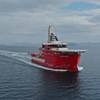Wärtsilä's' BWMS for New Crane Ship Design
A new crane ship designed by Netherlands based Royal IHC, a global leader in offshore, dredging and mining vessels, will feature the Wärtsilä Aquarius UV Ballast Water Management System (BWMS). The first vessel of this design is currently under construction at a shipyard in China. It is being built for Scaldis Salvage BV, a Belgium based offshore marine contractor. The contract with Wärtsilä was signed in the third quarter, 2015.
The Wärtsilä BWMS to be supplied has been specially designed to meet the space requirements of this vessel. In addition to the compact solution, Wärtsilä has also provided engineering support to both the designer and end-user so that the system can be correctly operated in accordance with the regulations. Wärtsilä has earlier been contracted to supply the main engines and gensets for this vessel.
"Wärtsilä's in-depth understanding of the BWMS regulations and knowledge of the compliance requirements was one of the main considerations in the award of this contract. It is important for us, as this will be the first Wärtsilä BWMS to be installed in a Royal IHC designed ship, and the first in the coastal workboat market," says Joe Thomas, Director, Ballast Water Management Systems, Wärtsilä Marine Solutions.
"Wärtsilä offers products and solutions that cover all technical aspects of the shipping and energy markets. All operations are ultimately inter-related, which is why we, as a total solutions provider, are in the unique position of being able to 'connect the dots' so that the entire chain can be completed as efficiently and effectively as possible. BWMS is one more important 'dot' in formulating a completely sustainable environmental solution," adds Joe Thomas.
Link to image of Wärtsilä Aquarius UV Ballast Water Management System
The importance of BWMS
Shipping is an international business with vessels travelling to and from different parts of the world. The ballast water that ships need is, therefore, taken on and discharged as required to ensure that the ship remains a safe operating platform. Thus, the ballast water can be taken from a body of water in one part of the world and discharged in another. Carried with the water is inevitably a host of microscopic marine organisms and plants, which unfortunately do not all adapt easily to their new environment. Those that do survive, however, can thrive, attack, and harm the local species and environment. When scientists brought their concerns to the world stage, the focus resulted in the IMO (International Maritime Organization) introducing the 2004 Ballast Water Management Convention. In 2013, the USCG introduced VGP 2013 legislation relating to ships sailing in US waters.








